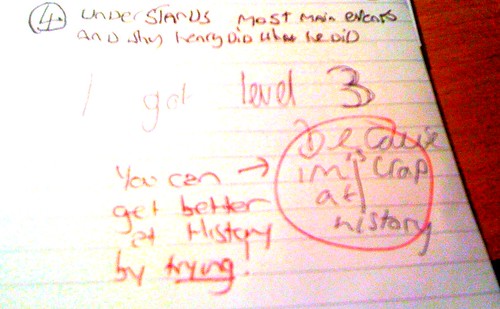How I mark students’ books.
I’d love to mark blogs (or even Google Wave) rather than exercise books. In my previous school I used Posterous-powered blogs with my Year 10 History class. However, in some situations it’s just not practical for various reasons. This isn’t the post to go into the ins and outs of why this is the case. This is the post that explains how I mark books with some justification behind my actions. One reason for putting my system online is to get feedback as to how I can improve it.
Let me just say right from the outset that I don’t mark as often as other teachers. Or as often as they claim to, anyway. In fact, during these half-term holidays is the first time I’ve marked my classes’ books this year. I would have ordinarily have liked to look at them before now (after 2-3 lessons) but setting up a new Academy kind eats into any free time you’ve got…
One more thing by way of context. It’s usual, but not universal, in England for Key Stage 3 students – whom I’m talking about here – to get one lesson of History (my subject) per week. Marking their books at the end of the half-term means they’ve got a maximum of 6 lessons work in there.
With that out of the way, let me explain how I go about marking. I do it in two ‘waves’:
First wave
In the first wave I’m concentrating on the following:
- Encouraging students
- Completion of work
- Understanding of key concepts
- Spelling of key words
- Factual errors (to correct)
If I notice a pattern across books (either all or a subset of them) then this informs my teaching and/or direction of Learning Support Assistants.
I used to mark in green, after hearing that some students find red a ‘confrontational’ colour. However, after having students in two separate schools complain about this, I’m back on the red. That’s handy, as green pens are more expensive and harder to get hold of!
Sometimes I fall into the trap of ‘ticking’ work. There’s really no point in this, but I do it to reassure students that I’ve seen a piece of work that doesn’t really require any comment. I focus my time and effort on things that are likely to make a difference to their learning. Sometimes this is reinforcing/correcting understanding of a key concept; sometime it’s encouraging a student; sometimes it’s drawing attention to spelling of key words. It depends on what you’re teaching and who the student is.
Second wave
Once I’ve been through exercise books with a red pen, I revisit them (the ‘second wave’). The purpose of this is to:
- Make a summative comment on how each individual student is doing.
- Inform the student on work that’s missing from their book.
- Highlight 3 ways they can improve.
- Enter data into a grid showing homework completion.
- Add notes, comments and indicative levels to my (online, Google Docs-powered) gradebook
Before I started to do this (or an iteration of it) I noticed that students wouldn’t read the comments I made on books. Having an obvious bookmark (such as that provided by the full-page feedback) gets them reading what I’ve said. By observing a colleague at my previous school I’ve also realised the importance of building time into a subsequent lesson to let them read what you’ve said. :-p
Conclusion
This marking system takes time. The thing that actually takes the most time is the chasing up of books that haven’t been handed in for marking, students who haven’t completed homework, and monitoring the catch-up work of absentees. Once students get used to the system, however, they seem to like it. After all, they know that I’ve been through their books carefully and given personalised feedback. They appreciate that. 🙂
Comments? Suggestions? Use the comments section below!



